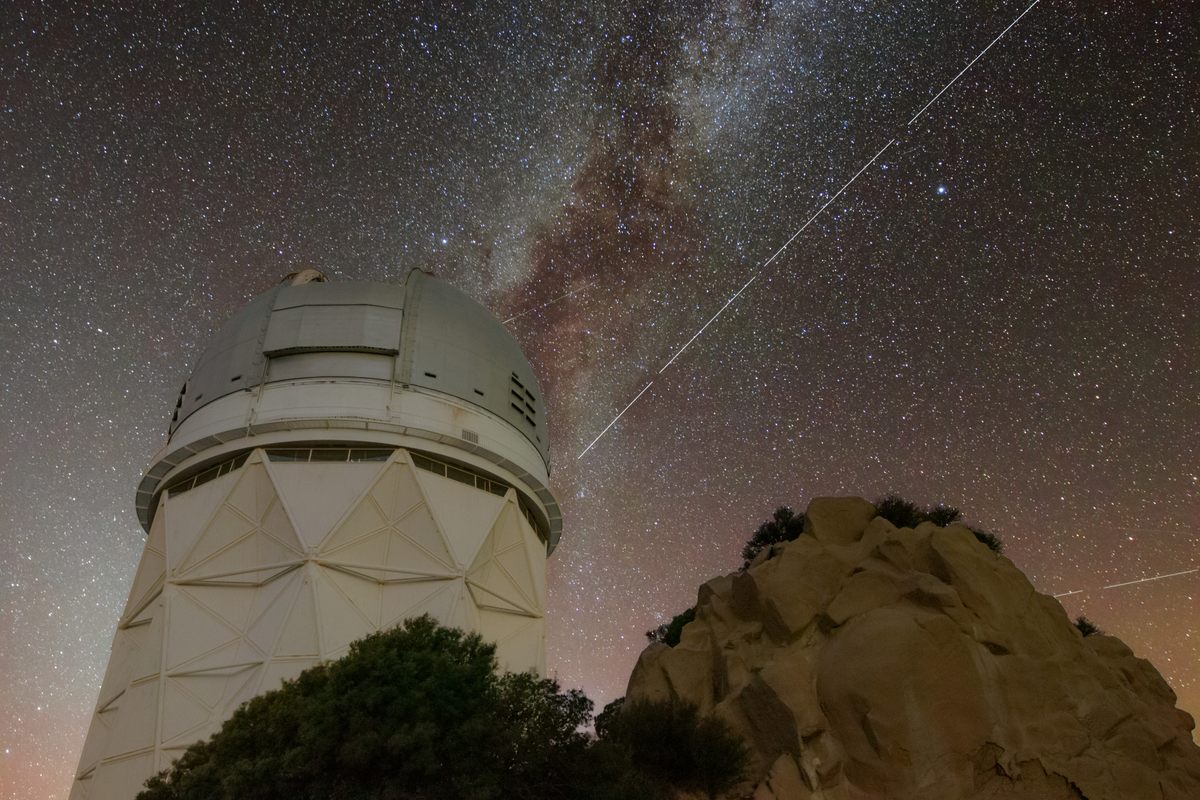Spot the ISS and Other Satellites in Our Busy Night Skies
The International Space Station and a growing number of communications satellites have redefined humans’ view of the heavens.
Atlas Obscura’s Wondersky columnist Rebecca Boyle is an award-winning science journalist and author of the upcoming Our Moon: How Earth’s Celestial Companion Transformed the Planet, Guided Evolution, and Made Us Who We Are (January 2024, Random House). Throughout the summer, she’ll be sharing the stories and secrets of our wondrous night sky.
Sitting outside late at night, even after most people are asleep, provides a sense of togetherness like few other things I know. I have never been lonely in the darkness or afraid of the night; I have loved the stars too fondly, as the poem says. Each twinkling star is a sun setting on some distant planet. Each planet is a world unto itself. Each nebula is a nursery for stars—or their graveyard. And sometimes, among all of it, we can catch a glimpse of ourselves up there, too.
This summer, while looking for nearby stars, familiar asterisms, the Moon, and deep sky objects, you might see an occasional interloper.
If you’re lucky, you might catch a passing blaze of bright yellow or maybe even green, a flash traveling at speeds hard to fathom. This is a meteor, a piece of space dust or debris that crossed Earth’s path and met a fiery end in our atmosphere. But more often, if you sit and look a while, you will see a slowly moving object arcing across the sky. At first you might mistake it for a star, until you realize it is moving too fast. You might also mistake it for an airplane, but once you see a couple of those, you will quickly spot the difference between an airplane and a satellite. The brightest of these celestial travelers is the International Space Station.

Humans have been living up there, without interruption, since November 2000. This is one of those quotidian facts that sometimes makes me stumble mid-sentence. People have been living off-world for nearly a quarter century. The ISS can be described as many things—an unparalleled microgravity laboratory, a testament to international cooperation, an awkward vestige of the Cold War, a colossal proving ground for living beyond Earth—but when you just sit outside and look at it, and see it sail past, you might be reminded that it is, above all, an incredible achievement.
The ISS orbits Earth in a spiral pattern, looping around the planet 16 times per day. It never travels beyond 51.6 degrees north or south latitude, so it doesn’t go over the poles, but it does go over 90 percent of the human population. The structure is as big as an American football field, including the end zones, and its gargantuan solar panels reflect lots of sunlight, so it is very bright, especially before sunrise and after sunset. If you want to find it, NASA offers telemetry a few days ahead of time, so you can figure out where to look and at what time, based on your location. Remember learning about degrees of arc last week? That will come in handy when it comes time to look for the station’s position relative to the horizon. Recall that a fist held at arm’s length covers about 10 degrees of sky, and that will help you judge how high above the horizon you should look.
This widget will tell you how:
Right now, as is typical, the ISS crew members are a mixture of American astronauts and Russian cosmonauts. They are Americans Frank Rubio, Stephen Bowen, and Warren “Woody” Hoburg; Russians Sergey Prokopyev, Dmitri Petelin, and Andrey Fedyaev; and Sultan Alneyadi of the United Arab Emirates. If you find the station, remember that in that inky darkness there are seven human beings looking down on the rest of us.
The ISS is relatively easy to find, bright as it is within the zone called low-Earth orbit, which includes anything less than 1,200 miles above Earth’s surface. Thousands of other satellites orbit here, and more still in a higher-altitude geosynchronous orbit. Most satellites are too distant to see with unaided eyes, though from a dark location you might spot some of them, especially a relatively new group of communications satellites, such as BlueWalker 3, which can be seen even from urban areas.
When it unfurled its array of small antennas in November 2022, BlueWalker 3 spanned 689 square feet, the size of a small apartment and about 10 times the width of many other communications satellites. Astronomers soon noticed it outshone most of the stars in the sky, comparable to the bright star Sirius. BlueWalker 3 might appear even brighter than that at times, depending on its altitude above Earth and the direction it is orbiting relative to the sun’s location. The company behind it, AST SpaceMobile, plans to launch dozens of similar satellites to provide service directly to unmodified cellphones using standard frequencies. In the near future, the sky could be full of these artificial stars.

The most prominent of these new additions to our night skies are the Starlink satellites, launched by SpaceX. These are also communications satellites, sending the internet directly into homes. SpaceX launches them in groups, so right after they launch, when they are still at low altitudes, they look like a glittering train in the sky. As they reach higher orbits, they become less visible to unaided eyes, but they are still so bright that they regularly interfere with astronomical observations—even the vaunted Hubble Space Telescope is not immune to their polluting effects. Astronomers are horrified, and widely concerned that these satellites represent an existential threat to their field, even while some acknowledge that the dazzling string of lights in the sky are beautiful in a certain kind of way.
No matter what you think of their potential harm or benefit, satellites, in a very real sense, are an extension of who we are. And if there is any life out there, from worlds not our own, those blinking emissaries might be the first things they encounter should they travel our way.
Is there something you’d like to know about our brilliant night sky? Share your stargazing questions with us and you may see them answered in a future Wondersky column!










Follow us on Twitter to get the latest on the world's hidden wonders.
Like us on Facebook to get the latest on the world's hidden wonders.
Follow us on Twitter Like us on Facebook